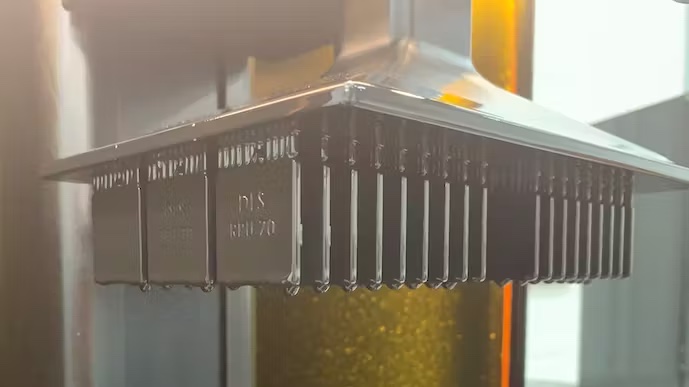Xometry (Nasdaq: XMTR) continues to grow, reporting record revenue, gross profit, and margins in its second quarter of 2024 earnings. The company’s diverse portfolio of manufacturing technologies, including 3D printing, has proven to be a powerful asset in navigating a complex and competitive industry. This success is largely attributed to its AI-powered marketplace, which “continues to gain significant market share as more customers turn to Xometry for supply chain solutions,” explained CEO Randy Altschuler. He also pointed out that 3D printing remains a key component of Xometry’s offerings, especially as industries increasingly adopt next-generation manufacturing technologies.
The Role of 3D Printing
Although Xometry doesn’t disclose the exact revenue percentage from 3D printing, it’s clear that this technology is an integral part of the company’s offerings, particularly in sectors like aerospace, automotive, and medical devices. Altschuler remarks that while 3D printing is a key component of Xometry’s future growth, it operates within a broader ecosystem of manufacturing technologies that includes CNC machining, injection molding, and sheet cutting.
“This diversification allows Xometry to serve a wide range of customer needs, making it more resilient and adaptable in a rapidly changing market,” explained the executive.
This strategic advantage of not being a pure-play 3D printing company has clearly paid off for Xometry. As Altschuler has pointed out, “The ability to offer an integrated solution with AI-driven pricing and supply chain management has been key to our leadership in the market.” This approach has enabled Xometry to capture a larger market share and appeal to a diverse set of industries which rely on more than just 3D printing for their manufacturing needs.
For 3D printing specifically, the brand offers both polymer and metal 3D printing technologies, including SLS (Selective Laser Sintering), MJF (Multi Jet Fusion), FDM (Fused Deposition Modeling), and DLS (Digital Light Synthesis) for polymers, as well as DMLS (Direct Metal Laser Sintering) and binder jetting for metals. Xometry is steadily expanding its 3D printing capabilities, adding more materials and processes to the mix. By focusing on making things easier for both customers and suppliers, Xometry ensures that 3D printing remains a key part of its services, especially for projects like prototyping, small production runs, and creating end-use parts.
When considering the future of polymer versus metal 3D printing, Altschuler told 3DPrint.com that it’s not about one technology outpacing the other. In fact, he compared it to choosing between one’s children, emphasizing that both technologies are essential to Xometry’s strategy and each has unique strengths.
AI-Powered Growth and Profitability
A key highlight of Xometry’s second-quarter performance is its record gross margin of 33.5%, largely driven by its AI-powered marketplace. The advanced AI algorithms that Xometry uses improve the matching process between buyers and suppliers, ensuring competitive pricing and efficient supplier selection. This efficiency has not only boosted margins but also strengthened Xometry’s position as a market leader. What’s more, this AI-driven model allows Xometry to expand operations while keeping costs low, a critical factor as the company moves toward profitability.
“Our AI-driven marketplace is not just about automation; it’s about enhancing our entire operation, from pricing to supplier engagement, which has been instrumental in driving our success and achieving these record margins,” Altschuler remarked. “We delivered record revenue, record gross profit, and record gross margins as our AI-powered marketplace continues to gain market share. The combination of data-driven AI and supplier network expansion will fuel robust growth and continued margin improvement.”

Xometry Integrates Teamspace Collaboration Tool Into Its AI-Powered Marketplace. Image courtesy of GlobeNewsWire.
Xometry is targeting adjusted EBITDA profitability once it reaches a revenue run-rate of $600 million, supported by a consolidated gross margin of between 38% and 40%, explained Altschuler. In the third quarter, the company expects an adjusted EBITDA loss of between $1.5 million and $3.5 million, reflecting continued investment in growth initiatives and international expansion. Despite the current challenges, Xometry has made significant progress in improving its margins and expects to maintain this momentum by focusing on cost management, operational efficiency, and scaling its operations. What’s more, management remains confident in achieving profitability as the company continues to expand its market share.
Even in the current challenging macroeconomic environment, Xometry reported a 19% year-over-year increase in revenue, reaching $133 million. This increase is driven by the company’s business model, which attracts new buyers and expands its supplier network. Moreover, Xometry’s ongoing expansion of AI capabilities, including partnerships with Google’s Vertex AI, is expected to boost its marketplace offerings, particularly in the 3D printing sector.
International Expansion: A Key Growth Driver
International markets are playing an increasingly vital role in Xometry’s growth strategy. In the second quarter, the company saw a 31% year-over-year increase in international revenue, driven by strong growth in Europe and Asia.
Xometry’s strategy of localizing its marketplaces to cater to regional needs has been particularly successful, with the company now offering services in multiple languages and currencies, especially in regions such as Europe, where it operates in 15 different languages.
In the Asia Pacific Region, Xometry has been expanding its offerings, including launching better customer service capabilities in China and expanding into new English-speaking countries like Australia, Singapore, and New Zealand. Altschuler has also pinpointed Latin America as a “region of interest,” with future offices in Mexico.
Industry Analyst Insights
Brian Drab of investment bank William Blair noted Xometry’s strong performance, especially its ability to grow marketplace gross margin even in a tough macroeconomic backdrop. He pointed out that “although Xometry has shown susceptibility to broader macroeconomic forces, we continue to believe in the business model and are positive regarding the company’s long-term growth prospects.” Another highlight has been its active buyers and active sellers which have both more than tripled since 2019. Drab also mentioned that Xometry’s diverse portfolio gives it an advantage over companies focused solely on 3D printing, helping it capture more of the manufacturing services market.
At $16, Xometry shares trade at 1.3 times Drab’s 2025 revenue estimate. Drab explained, “The average sales multiple for selected industrial technology companies is 5.8 times based on 2025 consensus estimates.” He also noted that, with respect to fast-growth internet marketplaces, Xometry’s enterprise-value-to-gross-profit ratio is comparable to the enterprise-value-to-net-revenue ratio for internet marketplaces, given that Xometry reports revenue on a gross basis.
However, not all analysts are equally bullish. Cantor Fitzgerald’s Troy Jensen, in a report issued prior to Xometry’s Q2 earnings release, expressed caution, citing the company’s high exposure to prototyping and the challenges of achieving aggressive revenue growth targets in the second half of 2024. Even so, most analysts are still optimistic, recognizing Xometry’s innovative approach and solid execution as important factors that should keep driving its success.
As Xometry continues to grow, it faces the challenge of maintaining its momentum while dealing with the complexities of expanding globally and keeping up with the latest technology. The company’s focus on AI and its wide range of manufacturing options puts it in a strong position to handle these hurdles.
Looking ahead, Xometry has provided guidance for the third quarter of 2024, expecting revenue to be between $136 million and $138 million, with an adjusted EBITDA loss ranging from $1.5 million to $3.5 million. With a goal of achieving adjusted EBITDA profitability soon, Xometry is on track to solidify its place as a leader in the on-demand manufacturing market.
Subscribe to Our Email Newsletter
Stay up-to-date on all the latest news from the 3D printing industry and receive information and offers from third party vendors.
Print Services
Upload your 3D Models and get them printed quickly and efficiently.
You May Also Like
Formnext Asia Shenzhen 2025: When Boring Beats Brilliant
“While Western companies fight for novelty, China fights for acceptance.” This observation, scribbled in my iPhone note app during Formnext Asia Shenzhen, held from August 26 to 28, captures what...
Adaptiv AI: Ivan Madera’s Mission Is to Unify Manufacturing, from Desk to Shop Floor
When Ivan Madera left Morf3D in 2023, he wasn’t done solving manufacturing problems. After helping build one of the leading metal additive manufacturing (AM) companies in the U.S. and driving...
Reborn to Reshore: Why the Velo3D Story May Just Be Getting Started
As someone who was born in 1988, I’ve lived through some pretty wacky economic disruptions. But I think that the mood now prevailing in the global business environment may make...
Data Dunes, AI Dreams: Additive Manufacturing’s Investment Puzzle
Remember Villeneuve’s Dune? The pursuit of rare and powerful spice (“venture alpha“) brought heroes into deserts hiding sandworms and shifting dangers (for those unfamiliar, think of a high-stakes quest through...

































